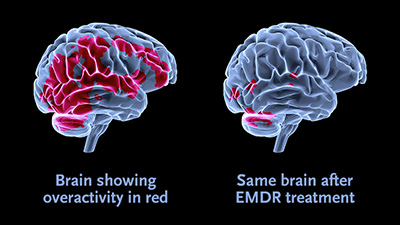We’re very pleased to have so many of our clinicians trained in EMDR, including Madeleine, Megan and me, as well as a dedicated EMDR therapist in Nina. However EMDR is still a relatively new treatment modality, and can sound more like science-fiction than an evidence-based trauma therapy, so Nina and I put together this article to explain a little about EMDR and how it can help keep the past in the past.
Danielle Graber
Clinical Psychologist & Director
EMDR – leaving the past in the past …..
A woman, let’s call her Nancy, comes to a counselling session because whenever her partner or boss becomes irritated with her, she gets overly upset. Nancy has a memory of being age 10, when her alcoholic step-father poked her with his finger whenever he criticised her. Now, when Nancy feels criticised, it’s almost like she is that helpless 10-year old again. Sometimes it’s like she even feels her step-father’s finger poking at her shoulder.
This is just one example of how trauma from an earlier adverse experience can impact on us in the here and now. When a past trauma is triggered by a current event, our adult brain shuts down and we can start to think and feel like the trauma is happening all over again. Any event that overwhelms our ability to cope can create a trauma reaction that stays with us into adulthood. Some of the adverse events that can lead to a trauma reaction include; neglect, abandonment, death of a parent, divorce, family violence, sexual abuse, serious medical illness, disability, war, natural disasters like fires or floods, violence, serious accidents or injury.
We may wonder why do I startle every time I hear a loud noise, a rustle in the bushes, a certain piece of music or even a smell? This is the trauma brain at work, constantly on the lookout for further trauma. It is quite separate from our wise and adaptive adult responses. Calming the trauma response and strengthening the adult ‘wise’ mind is where counselling, in particular EMDR and other trauma therapies can help.
Eye Movement, Desensitization and Reprocessing, or EMDR, was designed to disconnect the painful, emotional responses in the present from those past memories and traumas. It was first discovered in the late 1980s by Dr Francine Shapiro, an American psychologist, who serendipitously discovered EMDR during her famous “walk in the woods”, where she noticed that upsetting thoughts and feelings lessened when she sporadically moved her eyes from side to side. One of my colleagues and mentors in the United States jokes in his training workshops that the more likely version of the story is that Shapiro really discovered EMDR when she was in a Macy’s (equivalent to Myer or David Jones in Australia) car park looking frantically from side to side to find her car!
When a trauma or overwhelming adverse event occurs, it seems to get locked in the nervous system with the original picture, sounds, thoughts and feelings and this is why it can be retriggered in the present. The eye movements used in EMDR seem to unlock the nervous system and allow the mind and body to let go of the experience. Perhaps similar to the processing that occurs during REM (or Rapid Eye Movement) sleep.

For a lot of people who have experienced significant trauma though, the idea of actually consciously recalling the traumatic event can be utterly overwhelming in and of itself. What if someone doesn’t want to recall the memory or associated feelings, images or body sensations? That’s when the Flash Technique, developed in mid-2016 by Dr Philip Manfield, becomes important. The Flash Technique is used to help reduce the disturbance associated with painful memories without having to consciously recall the memory or re-experiencing the pain or distress associated with the trauma. This technique can be used as a preparation tool for EMDR or on its own.
While we don’t know the precise mechanism behind how EMDR works, the evidence is well and truly in that it does indeed work and work well.
In Nancy’s case, after a course of EMDR treatment, she described the past memories as more ‘distant’, and she could recall those memories without feeling small, belittled or defenceless. This improved her ability to assert herself and her needs and respond in the moment to criticisms without feeling overwhelmed emotionally or any unpleasant physical sensations (like that finger poking at her).
I for one feel very privileged to be involved in some of the amazing innovations that have made this possible and to be able to help clients unlock themselves from memories and traumas that have often haunted them for decades.
By Nina Zadurian
Psychologist and EMDR Therapist

